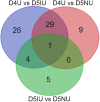Genome-wide analysis and functional prediction of long non-coding RNAs in mouse uterus during the implantation window
- PMID: 29137430
- PMCID: PMC5663602
- DOI: 10.18632/oncotarget.21031
Genome-wide analysis and functional prediction of long non-coding RNAs in mouse uterus during the implantation window
Abstract
Establishment of the receptive uterus is a crucial step for embryo implantation. In this study, the expression profiles and characterization of long non-coding RNAs (lncRNAs) in pregnant mouse uteri on day 4, day 5 at implantation sites and inter-implantation sites were conducted using RNA-seq. A total of 7,764 putative lncRNA transcripts were identified, including 6,179 known lncRNA transcripts and 1,585 novel lncRNA transcripts. Bioinformatics analysis of the cis and trans lncRNA targets showed that the differentially expressed lncRNAs were mainly involved in tissue remodelling, immune response and metabolism-related processes, indicating that lncRNAs could be involved in the regulation of embryo implantation. We also discovered that differentially expressed lncRNAs might regulate multiple signalling pathways that play an important role in the regulation of embryo implantation. In addition, nine known lncRNAs and four novel lncRNAs were randomly selected and validated by qRT-PCR. The expression of Tug1, Neat1, Gas5, Malat1, H19 and Rmst were significantly regulated in the mouse uterus during the implantation window. Our results are the first to systematically identify lncRNAs in the mouse uterus and provide a catalogue of lncRNAs for further understanding their functions in pregnant mouse uteri during the implantation window.
Keywords: RNA-seq; implantation; long non-coding RNAs; mouse; uterus.
Conflict of interest statement
CONFLICTS OF INTEREST The authors declare that there is no conflict of interest that could be perceived as prejudicing the impartiality of the research reported.
Figures




Similar articles
-
Long non-coding RNAs in human early embryonic development and their potential in ART.Hum Reprod Update. 2016 Dec;23(1):19-40. doi: 10.1093/humupd/dmw035. Epub 2016 Sep 21. Hum Reprod Update. 2016. PMID: 27655590 Review.
-
Genome-wide identification and characterization of long non-coding RNAs in developmental skeletal muscle of fetal goat.BMC Genomics. 2016 Aug 22;17(1):666. doi: 10.1186/s12864-016-3009-3. BMC Genomics. 2016. PMID: 27550073 Free PMC article.
-
Long Non-Coding RNAs (lncRNAs) of Sea Cucumber: Large-Scale Prediction, Expression Profiling, Non-Coding Network Construction, and lncRNA-microRNA-Gene Interaction Analysis of lncRNAs in Apostichopus japonicus and Holothuria glaberrima During LPS Challenge and Radial Organ Complex Regeneration.Mar Biotechnol (NY). 2016 Aug;18(4):485-99. doi: 10.1007/s10126-016-9711-y. Epub 2016 Jul 9. Mar Biotechnol (NY). 2016. PMID: 27392411
-
Aberrant expression of long noncoding RNAs in cumulus cells isolated from PCOS patients.J Assist Reprod Genet. 2016 Jan;33(1):111-21. doi: 10.1007/s10815-015-0630-z. Epub 2015 Dec 9. J Assist Reprod Genet. 2016. PMID: 26650608 Free PMC article.
-
Long noncoding RNAs: Novel insights into hepatocelluar carcinoma.Cancer Lett. 2014 Mar 1;344(1):20-27. doi: 10.1016/j.canlet.2013.10.021. Epub 2013 Oct 30. Cancer Lett. 2014. PMID: 24183851 Review.
Cited by
-
lncRNA/mRNA profiling of endometriosis rat uterine tissues during the implantation window.Int J Mol Med. 2019 Dec;44(6):2145-2160. doi: 10.3892/ijmm.2019.4370. Epub 2019 Oct 14. Int J Mol Med. 2019. PMID: 31638262 Free PMC article.
-
New Roles for EVs, miRNA and lncRNA in Bovine Embryo Implantation.Front Vet Sci. 2022 Jul 15;9:944370. doi: 10.3389/fvets.2022.944370. eCollection 2022. Front Vet Sci. 2022. PMID: 35909679 Free PMC article. Review.
-
Exploring the roles of fecundity-related long non-coding RNAs and mRNAs in the adrenal glands of small-tailed Han Sheep.BMC Genet. 2020 Apr 6;21(1):39. doi: 10.1186/s12863-020-00850-6. BMC Genet. 2020. PMID: 32252625 Free PMC article.
-
Epigenetic control of embryo-uterine crosstalk at peri-implantation.Cell Mol Life Sci. 2019 Dec;76(24):4813-4828. doi: 10.1007/s00018-019-03245-8. Epub 2019 Jul 27. Cell Mol Life Sci. 2019. PMID: 31352535 Free PMC article. Review.
-
Genome-wide identification and characterization of long non-coding RNAs expressed during sheep fetal and postnatal hair follicle development.Sci Rep. 2019 Jun 11;9(1):8501. doi: 10.1038/s41598-019-44600-w. Sci Rep. 2019. PMID: 31186438 Free PMC article.
References
-
- Yoshinaga K. A sequence of events in the uterus prior to implantation in the mouse. J Assist Reprod Genet. 2013;30:1017–22. https://doi.org/10.1007/s10815-013-0093-z. - DOI - PMC - PubMed
-
- Martinez-Conejero JA, Morgan M, Montesinos M, Fortuno S, Meseguer M, Simon C, Horcajadas JA, Pellicer A. Adenomyosis does not affect implantation, but is associated with miscarriage in patients undergoing oocyte donation. Fertil Steril. 2011;96:943–50. https://doi.org/10.1016/j.fertnstert.2011.07.1088. - DOI - PubMed
-
- Cakmak H, Taylor HS. Implantation failure: molecular mechanisms and clinical treatment. Hum Reprod Update. 2011;17:242–53. https://doi.org/10.1093/humupd/dmq037. - DOI - PMC - PubMed
-
- Li L, Chang HY. Physiological roles of long noncoding RNAs: insight from knockout mice. Trends Cell Biol. 2014;24:594–602. https://doi.org/10.1016/j.tcb.2014.06.003. - DOI - PMC - PubMed
-
- Chen G, Shi T, Shi L. Characterizing and annotating the genome using RNA-seq data. Sci China Life Sci. 2017;60:116–25. https://doi.org/10.1007/s11427-015-0349-4. - DOI - PubMed
LinkOut - more resources
Full Text Sources
Other Literature Sources

